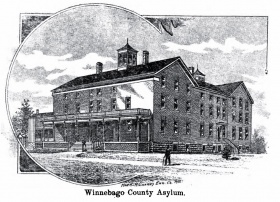Wisconsin Plan
The Wisconsin Plan, referred to as the 'Wisconsin System" was yet another system of state mental healthcare administration. The plan was Adopted in 1881 by the Wisconsin State Board of Charities and called for a system of county care for the chronic insane which was to be both supported and overseen by the State Board of Public Charities.
The Wisconsin Plan was designed to address the issue of overcrowding in State Mental Hospitals and care for the chronic insane. Up to this point there had been three trains of thought in terms of care for the chronically insane; the first, and one supported by Dr. Kirkbride was that all persons could be cured of insanity and chronic insane patients should be housed in regular State Hospitals in order to receive treatment like all other patients so they might be cured. This idea however had fallen disfavor favor as state hospital populations continued to rise and chronic patients continued to grow in number. Many states were forced to send chronic patients to county almshouses for custodial care. These almshouses often placed these insane patients in terrible conditions. To remedy this problem NY first implemented the Willard Plan in 1865 which created separate state Asylums for custodial care of the Chronic insane.
The third plan was devised in Illinois at Kankakee State Hospital, which opened in 1878. At Kankakee the state, under the direction of Frederick Howard Wines, Secretary of the Board of Public Charities, had created what is referred to as the Kankakee Plan, which was the first system to use cottages to segregate patients based on class. This created the first "dual system" hospital, combining medical care with custodial. The hospital consisted of a large Kirkbride congregate building to provide treatment for acute and curable patients. Behind this building was a "village" of cottages, meant to house 50-100 patients each, under the care of attendants. This plan served for some hospitals as a model but was soon surplussed by completely segregate institutions, abandoning the large congregate hospitals of the past.
By 1881 Wisconsin was still faced with the issue of housing the chronic insane in ill suited county almshouses as well as an increasing chronic population in its state hospital. To remedy this it was decided that the state would provide the counties with funding in order to care for the chronic insane of their county. These new county asylums, often originally run as a department of already existing Almshouse, were to be overseen by the State to ensure proper treatment. With the passage of the Wisconsin Plan of County Care many new county asylums were constructed, replacing previous buildings, often described as "prison like" in their design and administration. The new buildings were designed by board decision to provide accommodation for only 100 patients. This smaller number of custodial patients at each county asylum provided a proposed advantage in care over that of the Willard Plan, which often resulted in hospital with thousands of patients across a large campus housed in numerous buildings. This theory appears to have worked; according to a report from a special investigation into Wisconsin System published in 1895 "The general result of this investigation is that the treatment of the chronic insane in these county asylums were found to be uniformly of a high character." A report from an inspector from Pennsylvania in 1909 on the Wisconsin System found the patients were "better fed, better housed, and better cared for" than anywhere else in the United States.
The Wisconsin System proved very controversial and faced a great deal of opposition at the time. Many were skeptical at the ability of county board to provide humanitarian care for the insane. Much opposition also came from the fear that such a geographically scattered system would destroy the possibility effective oversight and management from the State. Dr. Wines, the key activist who led to the creation of the "Kankakee System", the first hospital to use cottages to segregate Chronic cases from acute, opposed the Wisconsin System in favor of his own. The AMSAII opposed the system as it left control to laypersons in the county rather than professionals in psychiatric care and Superintendents. Officials in New York, as well as other states insisted that large hospitals allowed greater treatment, care, oversight, and economy to the state.
Besides Wisconsin only Pennsylvania adopted a system of County Care, albeit with conflicting policies. Pennsylvania did open a Wernersville State Hospital to alleviate its problems with the Chronic Insane in 1890, though continued to heavily depend on its system of county operated asylums to provide care chronic cases. As of 1936 Wisconsin had 7,551 patients in county asylums with slightly over 2,000 in State Hospital. At this same time PA maintained 12,117 in county asylums with 12,713 in state hospitals.
Links & Additional Information[edit]
Annals of the American Academy of Political and Social Science, Volume 17
The Insane, and the Wisconsin system for their care
The Mad Among Us: A History of the Care of America's Mentally Ill


